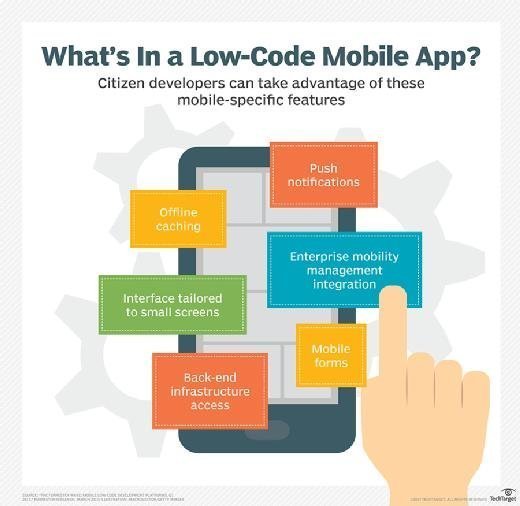Good Reasons On Picking Low-Code Platform Info
Wiki Article
The Benefits Of Low-Code Development For Speed
Visual Development Environment (VDE):
Drag-and-Drop Interfaces: Low-code platforms provide visual tools for designing applications. Developers can easily build an application using drag-and-drop elements without writing code.
Pre-built Templates and Components A number of low-code platforms include templates and components that are pre-built, which enable developers to swiftly develop and test applications without the need to begin from scratch.
Reduced Coding Requirements
Automated Coding Generation: Low-code platforms generate code automatically in accordance with the visual model created by developers. This removes the need to write the code manually and accelerates the process of developing.
Reusable Components: Developers can reuse components across different projects, thereby reducing the time spent writing and testing codes.
Collaboration Streamlined:
Integrated Development Tools : Low codes platforms usually have tools to test, version control and deployment. They help facilitate collaboration between teams.
Citizen Development: Business users as well as non-developers can contribute to the development of applications using simple interfaces, which can reduce the bottleneck often caused by limited access to professional developers.
Rapid Iteration and Prototyping:
Fast Prototyping : Developers create prototypes in a short time to validate concepts and get feedback. This leads to less time spent on iterations.
Easy Modifications. The visual interface low-code development gives allows users to easily update and change applications. This speed up the process of improving and refining the application based on the feedback of users.
Pre-built Integrations:
API Integrations Low-code platforms include already built connectors that can be used with the most popular APIs or services. They reduce the time it takes to connect external applications.
Data Integration: The built-in tools make it easier for connecting databases with other sources, accelerating the process of development.
Scaling and deployment:
One-Click deployment: A lot of platforms that use low-code offer an option to deploy applications, reducing time and effort.
Cloud-Based Platforms: Cloud-based platforms that are low-code allow for the management of the infrastructure and scale, which means developers can concentrate on the application logic and function rather than deployment logistics.
Low-code development of applications is a faster way to create apps. It simplifies and automates many aspects of the procedure. This makes it easier to speed up development and the ability to adapt to the changing needs. See the most popular wavemaker.com coding for site info including paas service, low code development platforms, driver jdbc, application modernisation, stored sql procedures, azure sql server, cross platform app dev, push notifications android, application modernization, app platforms and more.

Low-Code Apps Are Affordable.
Low-code application development has numerous advantages, such as cost-effectiveness. It is a popular choice for companies who wish to maximize their development budgets without compromising on quality. The main benefits are reduction in development costs:
Less Coding Needed: Low-code platform eliminates the need for lengthy manual coding. This means less time and effort of developers in developing applications. This also results in lower cost of labor.
Less developers: Since low code development is speedier and more simple, there are fewer specialized developer resources required. The cost of hiring and staffing could be significantly reduced.
Faster time to market
Accelerated Cycle of Development: Visual tools for low-code platforms and components facilitate rapid development of applications, which allows businesses to launch products more quickly. This may result in quicker revenue generation and better positioning in the market.
Rapid Prototyping. Businesses can quickly test and create prototypes. This reduces time spent in the development process and permits faster iterations that are dependent on the feedback of users.
Reduced Maintenance Costs
Because of their modular design and common components, low-code platforms typically make it easier to maintain applications. This reduces the cost of ongoing maintenance and support.
Automated Patches and Updates: Low-code platforms are able to manage updating and patching applications in a way that is automatic. This guarantees that the application is protected and always up to date without extensive manual intervention.
Efficient Resource Utilization:
Low-code platform contributions allow both business users and other non-developers to participate in the creation process. This makes it possible for companies to benefit from the talents of a diverse variety of employees.
IT departments can concentrate on Strategic Initiatives: Instead of getting overwhelmed by the daily development tasks IT departments are able to focus their energies on strategic initiatives that increase the efficiency and productivity of their departments.
Price models that are scaleable:
Subscription pricing: A lot of low-code platforms offer flexible pricing plans for subscriptions that scale with usage. This lets companies adjust their budgets according to their growth and requirements without having to pay large upfront cost.
Pay-Ass-You Go Options: Some platforms have pay-ass-you go options that ensure that businesses only pay for the time they utilize resources. This is particularly beneficial for small and start-up businesses with a limited budget.
Reduced Third-Party Software costs:
Low-code platforms have built-in functions and integrations, which could reduce the cost of subscriptions to software and licensing.
Pre-Built Integrations: The existence of pre-built integrations that integrate with the most popular services and systems minimizes the requirement for custom-built development, saving both time and money.
Increased ROI
A faster return on investment (ROI) Through making use of the rapid development process, lower costs and a shorter time to market, companies can get an increase in ROI for their applications.
Enhanced Ability. Businesses are able to quickly adjust to market changes and customer requirements to ensure they are relevant. They also can capitalize on new business opportunities that arise.
Low-cost Training:
User-Friendly Interfaces: The intuitive user-friendly interfaces on low-code platforms can reduce the learning curve for novice users, minimizing the need for extensive training programs.
Accessible Resources - A lot of low code platforms provide complete training materials and tutorials as well as community assistance. These tools reduce the requirement for formal instruction and the associated costs.
Collaboration is made easier:
Improved Collaboration Tools: Built-in collaboration tools aid in better coordination and communication among team members, resulting in better development processes and less project overhead.
Unified Development Environment. A single, unified software development environment can streamline processes and decrease the complexity and expense of managing different software and platforms.
In general, applications that use low-code are cost-effective due to their ability to reduce costs for development and maintenance as well as to speed time-to-market, to optimize resource usage, and to provide flexible pricing. These aspects provide significant financial benefits to business and make low-code a compelling option for organizations seeking to maximize their budgets while delivering solid, reliable, high-quality apps. Take a look at the top rated Enterprise application development with Low-code Platform for site advice including app modernisation, software for app development, build with docker, jdbc server, rapid action development, build a docker container, developing mobile apps, cross platform mobile app development, low code platforms, cloud software applications and more.

Advantages Of Low Code Application Development With The Limitations And Customization
Low-code development is a balanced approach to addressing the limitations of the system, while also providing the possibility of customizing. Here are some benefits:
Overcoming Complexity:
Development simplified: Low code platforms simplify the process by providing templates and pre-built elements. This facilitates faster application deployment, even for complicated ones.
A lot of platforms offer automated workflows that help developers to navigate through complex procedures. They minimize the risk of error and maintain uniformity.
Scalability Solutions
Scalability is a part of the Low-code platform often includes capabilities that permit scalable architecture. Applications can handle increased loads with minimal changes.
Performance Monitoring Performance Monitoring Tools: Integrated performance monitoring tools and optimization make sure that the applications run as efficiently as they can be, regardless of their scale.
Security and compliance
Low-code platforms come with security functions like security access control based on role, encryption, and automated checks for compliance. These security features address common concerns about security.
Platforms regularly update their security protocols to ensure that they are in compliance with the regulatory requirements. This helps to keep platforms safe from new threats.
Customization Options:
Extensibility:
Low-code Platforms Support Custom Code Platforms that allow the integration and usage of custom code.
Modifications and plugins that are custom Developers can design custom modules or plugins to provide specific features that are adapted to specific business needs.
APIs and Integration
API Support: The extensive support for APIs facilitates seamless integration with other systems and services. This allows for customizing and connectivity.
Third Party Services: Low-code platforms often have pre-built connectors to well-known third-party services, making it easier to integrate and customize applications.
Designing UI/UX that is flexible:
Customizable User Interfaces: Designers may alter and design user interfaces that are in line with the requirements for branding and usability to create a custom user experience.
Responsive design: The capacity to adapt applications to different screens and devices is included.
Business Logic Customization
Visual Workflow Builders They allow developers to develop complex processes using little or no programming. They can create business processes and workflows in a visual manner.
Conditional Logic & scripting : Platforms allow conditional logic, as well as customized scripting to meet specific business rules.
Data Management
Custom Data Modelling: Developers define custom models to fit particular requirements of the application. They can customize processing of data according to a company's requirements.
Advanced Data Processing: The integration of advanced tools and capabilities for data processing permits customizations to the way data is processed within an application.
Balance Customization and Limitations:
Frameworks and Standards
Low-code Platforms Encourage Industry Best Practices and Standards: Low-code platforms encourage the adherence of the industry's best standards and practices. This makes it easier to maintain high-quality, secure and adaptable applications.
Governance Frameworks. The built-in governance frameworks guarantee that modifications will not compromise the security, compliance or integrity of the software.
Iterative Development:
Rapid prototyping: The ability to quickly prototype and test modifications allows developers to modify their designs based on feedback from users improving the app to meet the needs of users.
Continuous Improvement: Low-code platforms allow constant improvement, allowing continuous customization and improvement as business requirements evolve.
Empowering Users:
Low-code platforms enable citizen developers by allowing non-developers through intuitive interfaces to customize applications, they increase the number of contributors who can modify and enhance apps.
Training and Support: Many platforms offer a wealth of assistance and training to help users with making efficient customizations without compromising the stability of the application or performance.
Low-code applications provide a flexible framework that can be tailored to meet specific needs. This ensures that businesses can create and maintain apps that are tailored and functional to meet their particular needs, while ensuring the highest standards of safety, quality and scalability.
